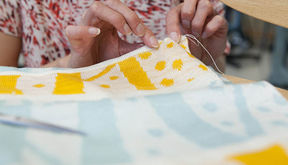Electronics from the forest

A panel discussion organised at Aalto University Academic Summit promised products that are both more ecologically sound and completely unprecedented.
Professor Magnus Berggren points at a beautiful Swedish forest landscape on the screen.
‘What if we could make electronics out of this?’ he asks.
Electronic waste, which is difficult to recycle, is one of the problems for which a solution might be found in the bioeconomy. Using wood as a raw material for manufacturing easily recyclable electronics still sounds like science fiction. However, this is not the case for the research group headed by Magnus Berggren, who is the Professor of Organic Electronics at Linköping University. The research group is able to manufacture different basic components for electronics - antennas, sensors, and transistors - on a cardboard platform with methods familiar from printing technology. Now researchers are using the same technology to develop biosensors that can be connected to people. With these sensors it is possible to monitor the state of the biological system.
‘You will be carrying a hospital with you,’ says Berggren.
The basic idea of the bioeconomy is that non-renewable natural resources are replaced by renewable ones, that natural resources are used in a sustainable manner, and that the material cycle in the production process is closed. The best bioeconomy resources are often substances that are currently classified as waste. Speakers at the Aalto University Academic Summit's bioeconomy seminar gave examples of the possibilities offered by the bioeconomy.
‘Aalto University has excellent conditions for creating new bioeconomy innovations,’ Laine says.
‘A good example of bioeconomy products is the Ioncell textile fibre,’ said the chair of the panel, Dean Janne Laine, before the start of the panel discussion. be Cellulose fibre, which is produced with the Ioncell manufacturing process developed by Aalto University researchers, is a more ecological alternative to cotton. It is more and more difficult to increase the production of cotton because of the amount of water and land needed for its cultivation. The raw material for Ioncell fibre comes from Finnish pulp mills.
‘Aalto University has excellent conditions for creating new bioeconomy innovations,’ Laine says. For instance, all the potential expertise at the university, from engineering skills related to forest products technology all the way to business and design expertise, has been utilised in the development work for the new fibre.
One of those who responded to the challenge is Academy Professor Olli Ikkala. Ikkala's research group in new materials is familiar with the secrets of nanocellulose. When wood cellulose fibres are ground down to nano size, 1000 times shorter than the cellulose fibres of paper, completely new kinds of product possibilities emerge.
‘Many strong materials are actually brittle,’ Olli Ikkala says.
Nature has solved the problem: natural pearls, for instance, are made of a material that is both strong and resilient. Nanocellulose offers engineers one way to imitate nature and to build nano composite materials whose characteristics are even better than nacre.
The possibilities offered by the bioeconomy are of interest to the traditional wood processing industry, which is looking for new products to complement paper and pulp. This is evidenced by the fields of research of the winners of the Marcus Wallenberg Prize, the ‘Nobel Prize’ of wood processing technology. The prize for 2014 was won by Professor Magnus Berggren who has developed printable electronics, and in 2013 the winner was nanocellulose researcher Derek Gray.
The raw material for Ioncell fibre comes from Finnish pulp mills.
In the future, the selection of products offered by the forest industry will include, in addition to paper, nanocellulose, liquid biofuels and raw materials for the chemical industry. Most basic chemicals used by the chemical industry, which have traditionally had oil as their raw material, can already be produced from renewable raw materials in biorefineries. The plastics industry, for example, can move into the realm of bioeconomy in the future.
‘We can already replace chemicals with bio-based materials – technically’, confirms panellist Ed de Jong, Vice President of Development at Avantium Chemicals, a Dutch company.
As the prices of fossil fuels rise and our understanding of bioproducts grows, the competitiveness of bioproduction will improve.
‘Over time the bioeconomy will become a cost-effective form of mass production. At the same time manufacturing oil-based products will become less cost-effective. It is not a bad idea to prepare for this,’ Olli Ikkala says.
Academy Professor Olli Ikkala from Aalto University, Professor of Organic Electronics Magnus Berggren from Linköping University, and Vice President of Development Ed de Jong from Avantium Chemicals, a Dutch company, discuss the possibilities offered by the bioeconomy at the bioeconomy panel of the Aalto Academic Summit week.
Aalto University's Bioeconomy Stars
The following people develop bioeconomy innovations of the future in their research groups.
- Olli Ikkala, Molecule Materials
- Herbert Sixta, Forest Products Technology
- Markus Linder, Biomolecular Materials
- Tapani Vuorinen, Wood Chemistry
- Jukka Seppälä, Polymer Technology
Photo: Mikko Raskinen
- Published:
- Updated:
Read more news

Get to know us: Associate Professor Maria Sammalkorpi
Sammalkorpi received her doctorate from Helsinki University of Technology 2004. After her defence, she has worked as a researcher at the Universities of Princeton, Yale and Aalto.
Aalto computer scientists in ICML 2024
Computer scientists in ICML 2024
Getting bacteria into line
Physicists use magnetic fields to manipulate bacterial behaviour